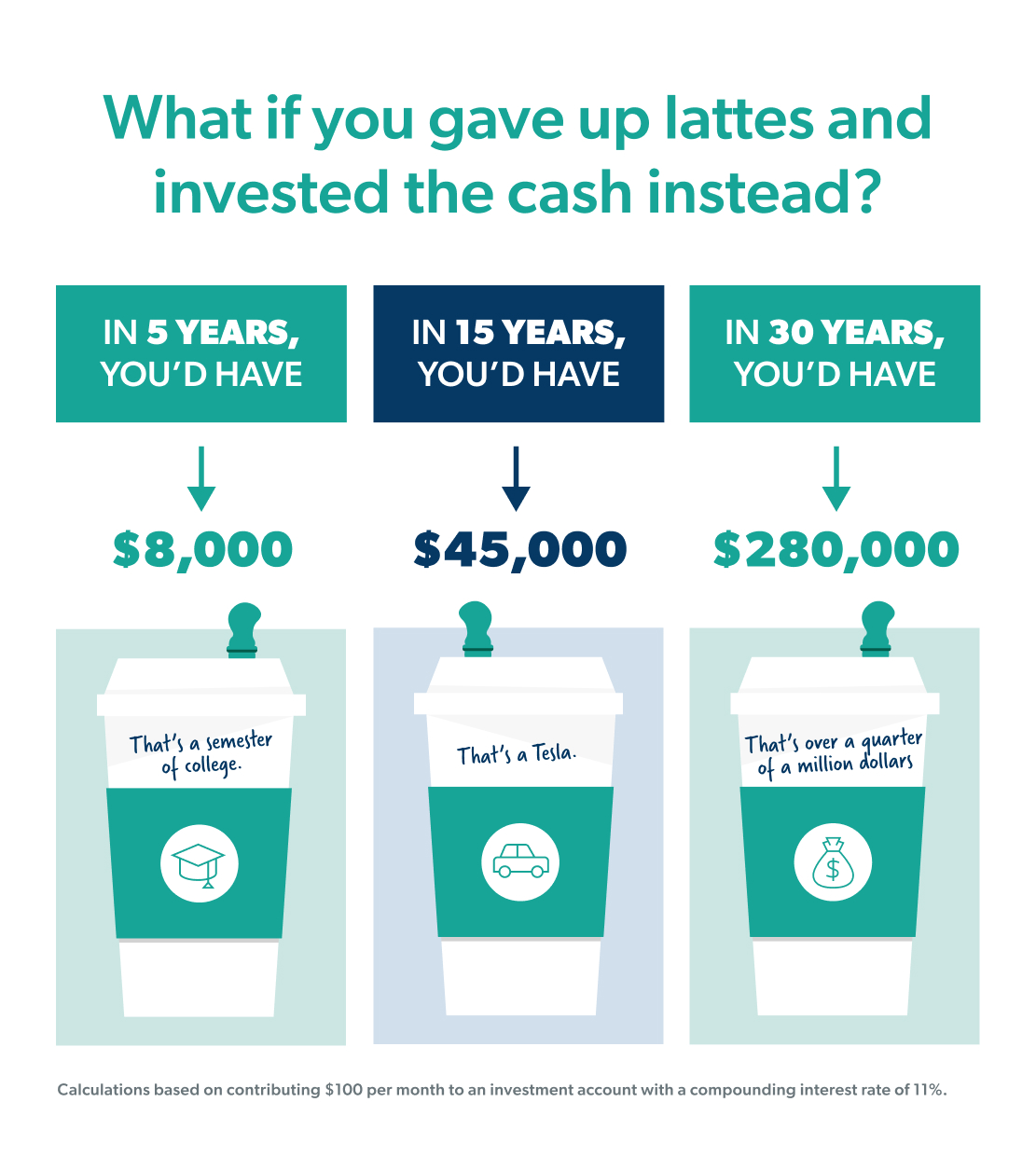
Key Takeaways
· When you set financial goals, make sure they’re specific and measurable, such as saving a set amount by a deadline. Break down big goals into smaller chunks so you have a vision of where you’re going.
· Your goals should be your own. Go after financial goals that make sense for you, and don’t compare yourself to others.
· Write down your financial goals to serve as a visual reminder and keep you motivated.
· Find an accountability partner who can provide support and encouragement along the way.
Do you feel like you’re trying so hard to make the right decisions with your money but never seem to get ahead? Or have you been working your butt off, maybe even picking up a side hustle, but you don’t have much to show for it at the end of the month?
Sure, things like inflation and recessions are real and can feel like huge road blocks to your financial goals. But even when the economy isn’t going crazy, if you don’t set any goals for your money, you’ll definitely feel like you’re spinning your wheels.
If you want to make progress with your money (for real), you need to set some financial goals. But don’t freak out. I’m going to help you figure out what your financial goals actually are—and share the steps to reach them. You’ve got this!
What Is a Financial Goal?
A financial goal is any plan you have for your money. You can have short-term financial goals (like saving up $1,000) or long-term financial goals (like buying a house or investing for retirement). It’s a good idea to set goals for every area of your life, but having specific financial goals means you’re committing to what you want out of life by planning to save and spend money for those things.
But depending on your relationship with money, trying to decide what to do with it can feel as overwhelming as choosing what to watch on Netflix or as exciting as planning a vacation to Disneyland. There are so many options. But you can’t watch all the home makeover shows or ride all the rides at once. You’ve got to pick and choose, and I recommend tackling your goals in an order that’ll set you up for lifelong success. But first, let’s talk about how you can get in the mindset of setting goals.
6 Steps to Setting Financial Goals
Lots of things can influence the way you set your financial goals, including your motivations, values and dreams for the future. And the way your parents handled money and even your own spending and savings habits (which are unique to you) also has a major impact on how you handle money.
Goal planning takes intention and some self-awareness, so carve out time to think about your goals. Find a few minutes to sit down with a cup of coffee or a glass of wine and get ready to dream—big! Once you have a list of goals for your money in mind, you’re ready to break them down into smaller, actionable steps. Here’s how:
1. Make your goal specific.
One reason people don’t hit their money goals is because they’re too vague. You might say, “I want to be better with money.” But what does that actually mean to you? Narrow it down. Or, “I want to upgrade my car someday.” Okay, fun! But what kind of car do you want, and when do you want to buy it?
What if you decided instead to tackle your debt? That’s a specific area of your money to focus on. Now, let’s talk about how to break this goal down even more.
2. Make your goal measurable.
Okay, so your goal is to pay off debt. Now it’s time to pick an exact amount—what you can measure to know if you hit your goal or not.
While being completely debt-free should be your ultimate goal, it’s a good idea to break down that goal into smaller chunks. That way, you have a vision of where you’re going before you get started.
Say you have $30,000 of total debt. You’ll want to start by paying off your smallest debt, like a $15,000 student loan, first. That’s what I mean by setting a measurable goal.
New! The Total Money Makeover – Updated and Expanded Edition
3. Give yourself a deadline.
Here’s the deal: It’s super easy to put off your goals when they aren’t time-sensitive. Stop saying you’ll start someday. You need to give yourself a deadline and make it reasonable—but also a little challenging.
Back to the student loan example: When do you want to hit your goal? If you want to pay off $15,000 in one year, you’ll need to pay $1,250 each month. Is this possible but also a bit of a stretch? If so, good!
Now, some goals fall into the short- to mid-term category, and these can be tackled in less than five or so. Think of long-term goals as ones you’ll achieve in five years or more. Here are some examples of short- and long-term financial goals:
Short- and mid-term financial goals:
- Saving up an emergency fund
- Saving for a vacation
- Paying for books for an upcoming semester of school
- Buying a new kitchen appliance or renovation
- Saving for an engagement ring
- Putting down a deposit on an apartment lease
- Saving for upcoming medical or dental services
- Buying birthday or Christmas gifts
- Saving a house down-payment
Long-term financial goals:
- Buying a new car with cash
- Paying for your kid’s college in cash
- Saving for retirement
- Launching a business
- Traveling for several months at a time
Expert Advice Delivered Straight to Your Inbox
Our weekly email newsletter is full of practical advice you can easily apply to your daily routine so you can win with your money, relationships and career.
4. Make sure they’re your own goals.
When we compare ourselves to other people, we’re playing a game we’ll never win. So, make sure you’re setting financial goals that make sense for you. In other words, just because all your friends are taking out second mortgages to renovate their kitchens doesn’t mean you should. Is that one Instagram influencer taking another extravagant vacation? Hey, good for them. But that doesn’t mean you need to do the same thing—or that you’re behind in life if you’re not in the same place. Put the blinders on, focus on your goals, and stay in your lane. And be clear on why you’ve chosen the goals you have.
5. Write your goal down.
Did you know you’re more likely to achieve your goals if you write them down? Yep, it’s true—there’s something about putting pen to paper that helps you commit to the task at hand.
So, go ahead and write down your goals. Then, stick them in your car, to your desk, or on your bathroom mirror. Type them in a notes app on your phone, take a screenshot, and set it as your wallpaper so it’s the first thing you see when you pick up your phone. Keeping your goals where you can see them will keep you on track and motivated.
6. Get a goal accountability buddy.
To take your goals one step further, find a goal accountability buddy. This could be your spouse, a close friend or a community—anyone who will cheer you on and check in as you keep working on hitting your goal. Having a cheerleader in your corner and knowing you’re not alone can make a huge difference as you work toward your goals.
5 Examples of Financial Goals
With so much money “advice” floating around, it can be hard to know which financial goals you should aim for first. This is why I have to mention the Baby Steps when I talk about setting financial goals. The Baby Steps will help you save for emergencies, pay off debt, and build wealth. But there’s a process to follow.
Should you pay off debt first? Save for your kids’ college? Buy a house? Invest for retirement? The 7 Baby Steps cut through all the confusion and give you a clear path to do all those things. Following the steps will help you focus on one goal at a time so you can make more progress with your money and feel financial peace.
If you have no clue what financial goal to go after first, start by taking this quick assessment to find out what Baby Step you’re on.
Here are some more of the most common financial goals people set and tips for making them happen. Are any of these on your list?
EveryDollar Budget App
1. Create and stick to a budget.
Not only is budgeting one of the top financial goals people set each new year, but it’s also the foundation you should build all your other money goals on.
A budget is how you make progress with your money. It’s a plan for what’s coming in (your income) and what’s going out (your expenses). You’re telling your money where to go instead of wondering where it went. When you have this plan for your money, you can feel confident you’re taking steps toward your goal every month.
Budgeting helps you gain momentum in every area of your finances. If you’re already budgeting, bravo! If not, get started for free with EveryDollar.
2. Build up an emergency fund.
Life happens. But you can be prepared for any money problems that come your way if you’ve got enough money saved up. I’m talking car trouble, medical expenses and busted toilets (you know, some of the most inconvenient parts of being an adult). But when you’ve got an emergency fund, you can rest well at night knowing you won’t have to go into debt to cover those moments.
Start with the financial goal of having $1,000 in savings. Then, if you have debt, it’s time to knock that out. (I’ll talk more about that in a minute.) After that, you want to build up a fully funded emergency fund with 3–6 months of expenses. (Again, this is all covered in the Baby Steps—the proven plan to help you take control of your money.)
When you’ve got an emergency fund, you’re ready for those “life happens” moments. Instead of being worried about what could happen next, you’ll feel confident that you’ve got money set aside to deal with it.
3. Get out of debt.
If you’ve got debt, it’s time to get serious about paying it off. All of it. Yeah, I know that may seem impossible right now, especially if you’ve got some big numbers staring you in the face—student loans, credit cards, whatever makes up that debt. But here’s the ugly truth: Debt doesn’t move you forward. It holds you back. You can’t get ahead with your money if it’s always going to lender payments.
4. Save up for your dream retirement.
Let’s take a second to put on our imagination caps and picture the ideal retirement. Maybe that’s five, 10 or 30 years down the road. Do you want to pack up the grandkids and head to Disney every Christmas? Visit a new state with your spouse once a quarter? Stay home and read every book on your shelves? Take up a fun hobby or travel for international cooking lessons?
No matter what you’re dreaming for the future, you’ll need good retirement investments now to make it a reality. After you’re debt-free and have a fully funded emergency fund, I want you to start investing 15% of your household income for retirement. And guess what? When you have zero debt, all that money you were spending on payments can go straight into your accounts to fund your retirement dreams.
5. Spend less and save more.
Tons of people whip goals out of the air, like “I want to spend less” or “I want to save more,” without thinking about what it means to actually do those things. People, you’ve got to be specific with your goals and intentional about your money habits.
Becoming successful with money is more about changing your behavior than anything else. This can look like creating and sticking to your budget every month, finding deals, using coupons, paying cash, making more money. And here’s a big one: You’ve got to learn how to say no—even to yourself. I’m not saying never have fun. But if you want to save money, it’s going to take some planning and lifestyle adjusting.
And finally, here’s one of my favorite tips for spending less and saving more: Plan your meals. Food is where most Americans overspend, and meal planning is how you rein that in. Check out my free Weekly Meal Planner & Grocery Savings Guide to see how to save time and money on food.
An Example of a Financial Goal in Action
Okay, so now that I’ve gone over the basics of financial goal planning, let me give you an example of how this can work in real life.
A while back, my husband, Winston, and I decided to build a house. Before that, all the extra income we brought in went straight to our general savings. But I knew building a house would cost a lot, and random, unexpected expenses were bound to pop up during the process.
So, we made it a goal to save up as much as we could—specifically toward our house. And while saving up that much money seemed almost impossible, breaking it down into monthly goals gave us so much momentum. Having a plan for our money not only made our dream possible, but it also made the process fun.
Having this goal for our money is also what kept my spending tendencies (aka spendencies—trust me, it’s a thing) in check. Knowing my money was going toward something I really wanted (way more than any late-night Amazon purchases) motivated me to spend less. And even though there were moments when we felt fatigued—I mean, there were some days when all I wanted to do was relax and spend money—finding creative ways to hit our goal faster kept us on track each month.
Beyond that, it was character building. It’s a time in our marriage that we’ll always look back on and know we accomplished something hard together. It helped cultivate connection between us and contentment in my own heart. Now I realize those benefits of the process are worth more than the new house.
Why Is Setting Financial Goals Important?
Having a goal helps you be more future focused with your money. You’ll start to see how every decision you make adds up and makes a difference with your overall financial health.
For example, if you don’t have financial goals, it’s no big deal to buy breakfast and coffee every day. But let’s look at just how much that’s really costing you. You’ll typically spend at least $25 for just one workweek of lattes—that’s $100 a month! What else could you do with that money?
If you put $100 in an investment account every month for five years, your latte fund could grow into more than $8,000, thanks to the power of compound growth. That’s a whole semester of your kids’ college you’re drinking.
Imagine if you thought even longer term and invested $100 a month for 15 years. Your latte savings could grow to over $45,000.
And if you invest your savings for 30 years? Your coffee money could grow to over $280,000. A latte a day or a quarter of a million dollars? You guys, I like a good cup of coffee—but not that much.
If you want to set yourself up to be financially secure, find small (or large) sacrifices you can make right now. The everyday things you do with your money today will absolutely affect your future.

Goals Will Get You Where You Want to Be
Financial goals will help you change your mindset, your habits and ultimately your life.
When you’re intentional with every dollar you have, you’re able to make your money go further. That means you get to do more of the stuff you want to do and plan for the things you’ll do in the future.
You can do more than you ever thought possible, but you’ll need financial goals to help you get there. Decide what you want your future to look like and figure out what you need to do today to make it happen.
You can live on your terms instead of the bank’s.
You can get out of debt once and for all.
You can build wealth and pay for things that matter to you.
If you’re already planning ahead and dreaming up a vision for the future, check out our Goal Tracker Worksheet. It’ll help you create and track your goals and stay focused along the journey. Goal setting doesn’t have to be intimidating, and this worksheet will help keep you heading in the right direction.
And remember, any financial goal you have starts with a budget. This is the foundation. It’s how you get organized and intentional with your money. Go ahead and start your free budget today with EveryDollar. Then, get moving on those six steps to setting and reaching your financial goals. No matter the time of year, you can turn these dreams into reality. Go get it!
Start Setting Your Financial Goals Today
- If you’re already planning ahead and dreaming up a vision for the future, check out our Goal Tracker Worksheet. It’ll help you create and track your goals and stay focused along the journey.
- Finally, get moving on those six steps I mentioned to setting and reaching your financial goals.
- Go ahead and start your free budget today with EveryDollar.




